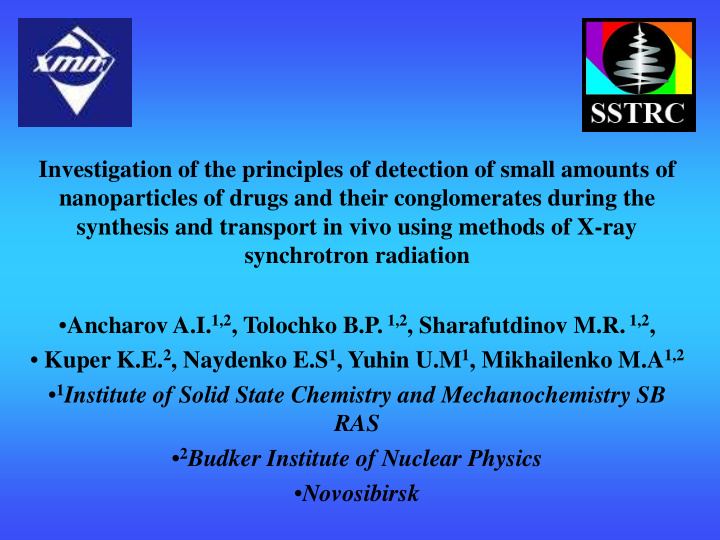



Investigation of the principles of detection of small amounts of nanoparticles of drugs and their conglomerates during the synthesis and transport in vivo using methods of X-ray synchrotron radiation • Ancharov A.I. 1,2 , Tolochko B.P. 1,2 , Sharafutdinov M.R. 1,2 , • Kuper K.E. 2 , Naydenko E.S 1 , Yuhin U.M 1 , Mikhailenko M.A 1,2 • 1 Institute of Solid State Chemistry and Mechanochemistry SB RAS • 2 Budker Institute of Nuclear Physics • Novosibirsk
The basic idea of the investigation is using the unique properties of the synchrotron radiation can receive information about the drug are in the gastrointestinal tract (GIT) of a living body at low concentrations. In particular: the phase state, i.e, tablet dissolved in the stomach or not; the charge state, i.e, the drug is active or passive; of the time (and place) of sedimentation of the drug; about the localization of the drug on the damaged wall of the digestive tract. As an object of research we selected anti-ulcer drug substance based on bismuth tripotassium dicitrate (BTD). BTD is a drug with bactericidal activity against Helicobacter pylori has anti- inflammatory and astringent. Work was carried out on behalf of the Ministry of Health RF for the development of domestic analogue drugs De Nol (Netherlands). The project succeeded in synthesizing a complete analogue of imported medicines De-Nol (Netherlands) and to explore its metabolism in the chemical environment similar to the environment in different parts of the gastrointestinal tract.
Antiulcer vehicle with bactericidal activity against Helicobacter pylori, also possesses anti-inflammatory and astringent properties. At pH 4 and below (gastric juice), the insoluble precipitate of bismuth oxychloride and citrate, chelate compounds are formed with the protein substrate (insoluble protective coating at the site of ulcer). By increasing the synthesis PgE , which increases mucus and bicarbonate secretion, stimulates the activity of cytoprotective mechanisms. Leads to accumulation of epidermal growth factor in the area of the defect. Reduces the activity of pepsin and pepsinogen. Improves the protective properties of the mucous membrane of the digestive tract. Increasing production of mucus, mucosal resistance to the effects of pepsin, HCl and enzymes.
The diffraction experiment was conducted at the experimental station of synchrotron radiation (SR) №4 VEPP -3. Medicament (in one experiment in the crystal, and in the other - in liquid form) was poured into the stomach of a turkey, and irradiated with a narrow beam with an energy 33.7 keV. With area detector Mar-350 diffraction pattern of the drug was reserved, imposed on the scattering from the tissue of the stomach. The main objective was to allocate the sum of the diffraction pattern information about the structure of the drug. The main result of the experiment - using SR can receive information about the crystal lattice of drugs in real biological object.
Diffractogram from BTD (black)and BTD in stomach of a turkey (blue).
Diffractogram from 1М solution BTD in water.
Diffractograms from 0.006М solution BTD in water (above) and from water (below).
Diffractograms from 0.083М solution BTD in water (black) and from the same solution with HCl, pH 3. ( blue).
Small angle x-ray scattering
22000 20000 18000 16000 14000 Int., a.u. 12000 10000 8000 6000 4000 2000 0 0.0 0.1 0.2 0.3 0.4 0.5 -1 q, A SAXS for BTD solutions: green – water, red -0.125 M, black – 0.5 M
K-edge digital submitted imaging KEDSI KEDSI a palladium of a containing preparation. Left (I1) and right (I2) the image is obtained in monochromatic radiation with the energy of photons laying 50 eV below and above the K-edge absorption of a palladium respectively.
Radiogram the alive laboratory mouse (at the left), distribution a palladium-containing of a preparation in a body of the alive mouse (on the right).
Recommend
More recommend